
VNU Journal of Science: Mathematics – Physics, Vol. 41, No. 1 (2025) 1-8
1
Original Article
An Inertial Forward-backward Splitting Method
for Monotone Inclusions
Nguyen Van Dung*, Hoang Thi Kim Hoa
University of Transport and Communications, 3 Cau Giay, Hanoi, Vietnam
Received 27th November 2023
Revised 05th March 2024; Accepted 17th February 2025
Abstract: In this work, we propose a splitting method for solving monotone inclusions in Hilbert
spaces. Our method is a modification of the forward-backward algorithm by using the inertial effect.
The weak convergence of the proposed algorithm is established under standard conditions.
Keywords: Monotone inclusion, Splitting method, Inertial effect, Forward-backward algorithm.
Mathematics Subject Classifications (2020): 47H05, 49M29, 49M27, 90C25.
1. Introduction*
Let consider the monotone inclusion of finding the zero points of the sum of a maximal monotone
operator 𝐴 and a monotone, 𝐿-Lipschitz operator 𝐵, acting on a real Hilbert space ℋ, i.e.,
find 𝑥‾∈ℋ such that 0∈(𝐴+𝐵)𝑥 ‾ . (1)
Throughout this work, we assume that a solution 𝑥‾ exists. This inclusion arises in numerous problems
of fundamental importance in monotone operator theory, variational inequalities, convex optimization,
equilibrium problems, image processing, and machine learning; see [1-4] and the references therein.
For solving problem (1), Tseng [5] proposed an algorithm called forward-backward-forward, namely:
𝛾∈]0,+∞[, {𝑦𝑘=𝐽𝛾𝐴(𝑥𝑘−𝛾𝐵𝑥𝑘),
𝑥𝑘+1=𝑦𝑘−𝛾𝐵𝑦𝑘+𝛾𝐵𝑥𝑘.
where 𝐽𝛾𝐴 denotes the resolvent of 𝐴, i.e. 𝐽𝛾𝐴=(Id+𝛾𝐴)−1,
________
* Corresponding author.
E-mail address: dungnv@utc.edu.vn
https//doi.org/10.25073/2588-1124/vnumap.4900

N. V. Dung, H. T. K. Hoa / VNU Journal of Science: Mathematics – Physics, Vol. 41, No. 1 (2025) 1-8
2
where Id is identity operator on ℋ. A limitation of this method is that at each iteration step, one has to
compute twice times the values of operator 𝐵. This issue was recently resolved in [6], the forward reflected
backward splitting method was proposed, namely,
𝛾∈]0,+∞[, 𝑥𝑘+1=𝐽𝛾𝐴(𝑥𝑘−2𝛾𝐵𝑥𝑘+𝛾𝐵𝑥𝑘−1). (2)
A method related to method (2) was suggested in [7], called the reflected forward-backward splitting
method: 𝛾∈]0,+∞[, 𝑥𝑘+1=𝐽𝛾𝐴(𝑥𝑘−𝛾𝐵(2𝑥𝑘−𝑥𝑘−1)). (3)
The convenience of method (2) and (3) is that in each iteration, we only need to calculate the value of
operator 𝐵 once.
In [8], Polyak introduced the so-called heavy ball method in order to speed up the classical gradient
method. For a differential function 𝑓:ℋ→ℝ, the algorithm takes the following form:
𝑥𝑘+1=𝑥𝑘+𝛼𝑘(𝑥𝑘−𝑥𝑘−1)−𝛾𝑘∇𝑓(𝑥𝑘).
This idea then employed and refined by some authors [9-13]. In [13], Lorenz and Pock proposed the
following inertial forward- backward algorithm for monotone operators' algorithm:
{𝑦𝑘=𝑥𝑘+𝛼𝑘(𝑥𝑘−𝑥𝑘−1),
𝑥𝑘+1=𝐽𝛾𝑘𝐴(𝑦𝑘−𝛾𝑘𝐵𝑦𝑘).
By using the inertial forward-backward algorithm above and the projection on a half space, in [10],
the authors derived the strong convergence result of the proposed method. In this work, we propose a new
method for solving problem (1). In our method a value of operator 𝐵 is also used in each iteration as
method (2) and (3). We also used the inertial effect to improve the performance of the algorithm. Under
standard conditions, we also obtained the convergence of the proposed method. In some examples, our
method gives better convergence rate in comparison with Tseng's method and the methods in [5,7].
The rest of this work is organized as follows. After collecting preliminaries needed in Section 2, we
present the proposed method and prove the convergence of the method in Section 3.
2. Preliminaries
The scalar product and the associated norm of the real Hilbert space ℋ are denoted respectively by
⟨⋅∣⋅⟩ and ∥⋅∥.
The symbols ⇀ and → denote respectively weak and strong convergence.
Let 𝐴:ℋ→2ℋ be a set-valued operator. The domain of 𝐴 is denoted by dom (𝐴) that is a set of all
𝑥∈ℋ such that 𝐴𝑥≠∅. The range of 𝐴 is ran (𝐴)={𝑢∈ℋ∣(∃𝑥∈ℋ)𝑢∈𝐴𝑥}. The graph of 𝐴 is
denoted by gra (𝐴)={(𝑥,𝑢)∈ℋ×ℋ∣𝑢∈𝐴𝑥}. 𝐴−1 stands for the inverse of 𝐴, i.e., 𝐴−1:𝑢↦{𝑥∣
𝑢∈𝐴𝑥}. The zero set of 𝐴 is zer (𝐴)=𝐴−10.
Definition 2.1 We say that operator 𝐴:ℋ→2ℋ is (i) monotone if
(∀(𝑥,𝑢)∈gra (𝐴))(∀(𝑦,𝑣)∈gra (𝐴)) ⟨𝑥− 𝑦∣𝑢− 𝑣⟩≥0.
(ii) maximally monotone if it is monotone and there exists no monotone operator 𝐵:ℋ→2ℋ such
that gra (𝐵) properly contains gra (𝐴), i.e., there is no monotone operator that properly contains it.
Definition 2.2 A mapping 𝑇:ℋ→ℋ is said to be L-Lipschitz continuous (𝐿>0) if
∥𝑇𝑥−𝑇𝑦∥≤𝐿∥𝑥 − 𝑦∥ ∀𝑥,𝑦∈ℋ.
Definition 2.3 For 𝐴:ℋ→2ℋ, the resolvent of operator 𝐴 is
𝐽𝐴=(Id+𝐴)−1,
where Id denotes the identity operator on ℋ.
Note that, when 𝐴 is maximally monotone, 𝐽𝐴 is an everywhere single-valued operator [14].

N. V. Dung, H. T. K. Hoa / VNU Journal of Science: Mathematics – Physics, Vol. 41, No. 1 (2025) 1-8
3
3. Proposed Method and Convergence
We propose the following method for solving problem (1).
Algorithm 3.1. Let 𝛾>0, let 𝛼≥0. Let 𝑥−1,𝑥0,𝑥1∈ℋ. Iterate (∀𝑘∈ℕ)
𝑥𝑘+1=𝐽𝛾𝐴[𝑥𝑘+𝛼(𝑥𝑘−𝑥𝑘−1)−𝛾(7
2𝐵𝑥𝑘−4𝐵𝑥𝑘−1+3
2𝐵𝑥𝑘−2)] . (4)
Let us give some comments on the above algorithm.
i) In (4), in each iteration, we have to calculate three forward values. However, in the next iteration,
we can use two forward values of the previous iteration. Therefore, we actually only compute one forward
value in every iteration;
ii) When 𝛼=0,𝐵=0, Algorithm 3.1 becomes the proximal point algorithm as in [15].
To prove the convergence of Algorithm 3.1, we have the following lemma.
Lemma 3.2. Suppose that (𝑥𝑘)𝑘∈ℕ is the sequence generated by Algorithm 3.1. Then for 𝑥∈zer (𝐴 +
𝐵), we get
∥
∥
𝑥𝑘+1−𝑥
∥
∥
2−𝛼
∥
∥
𝑥𝑘−𝑥
∥
∥
2+2𝛾𝑡𝑘+1+(1−𝛼−5𝛾𝐿
2)
∥
∥
𝑥𝑘+1−𝑥𝑘
∥
∥
2
≤||𝑥𝑘−𝑥||2−𝛼||𝑥𝑘−1−𝑥||2+2𝛾𝑡𝑘+(2𝛼+𝛾𝐿)||𝑥𝑘−𝑥𝑘−1||2+3𝛾𝐿
2||𝑥𝑘−1−𝑥𝑘−2||2,
where 𝑡𝑘=⟨𝐵𝑥𝑘−1−𝐵𝑥𝑘∣𝑥𝑘−𝑥⟩+3
2⟨𝐵𝑥𝑘−1−𝐵𝑥𝑘−2∣𝑥𝑘−𝑥⟩.
Proof. From (4), we get
𝑥𝑘+𝛼(𝑥𝑘−𝑥𝑘−1)−𝑥𝑘+1
𝛾−(7
2𝐵𝑥𝑘−4𝐵𝑥𝑘−1+3
2𝐵𝑥𝑘−2)∈𝐴𝑥𝑘+1. (5)
For 𝑥∈zer (𝐴 + 𝐵), then −𝐵𝑥∈𝐴𝑥. Hence,
⟨𝑥𝑘+𝛼(𝑥𝑘−𝑥𝑘−1)−𝑥𝑘+1
𝛾−7
2𝐵𝑥𝑘+4𝐵𝑥𝑘−1−3
2𝐵𝑥𝑘−2+𝐵𝑥| 𝑥𝑘+1−𝑥⟩≥0
which implies ⟨𝑥𝑘−𝑥𝑘+1+𝛼(𝑥𝑘−𝑥𝑘−1)
𝛾| 𝑥𝑘+1−𝑥⟩
≥⟨7
2𝐵𝑥𝑘−4𝐵𝑥𝑘−1+3
2𝐵𝑥𝑘−2−𝐵𝑥| 𝑥𝑘+1− 𝑥⟩. (6)
For the left-hand side of (6), we have
⟨𝑥𝑘−𝑥𝑘+1+𝛼(𝑥𝑘−𝑥𝑘−1)∣𝑥𝑘+1−𝑥⟩
=⟨𝑥𝑘−𝑥𝑘+1∣𝑥𝑘+1−𝑥⟩+𝛼⟨𝑥𝑘−𝑥𝑘−1∣𝑥𝑘+1−𝑥𝑘⟩+𝛼⟨𝑥𝑘−𝑥𝑘−1∣𝑥𝑘−𝑥⟩
=1
2(
∥
∥
𝑥𝑘−𝑥
∥
∥
2−
∥
∥
𝑥𝑘+1−𝑥
∥
∥
2−
∥
∥
𝑥𝑘+1−𝑥𝑘
∥
∥
2)−𝛼
2(
∥
∥
𝑥𝑘−1−𝑥
∥
∥
2−
∥
∥
𝑥𝑘−𝑥
∥
∥
2−
∥
∥
𝑥𝑘−1−𝑥𝑘
∥
∥
2)
+𝛼⟨𝑥𝑘−𝑥𝑘−1∣𝑥𝑘+1−𝑥𝑘⟩. (7)
Using the monotonicity of 𝐵, we estimate the right-hand side of (6) as:

N. V. Dung, H. T. K. Hoa / VNU Journal of Science: Mathematics – Physics, Vol. 41, No. 1 (2025) 1-8
4
⟨7
2𝐵𝑥𝑘−4𝐵𝑥𝑘−1+3
2𝐵𝑥𝑘−2−𝐵𝑥| 𝑥𝑘+1−𝑥⟩
=⟨7
2𝐵𝑥𝑘−4𝐵𝑥𝑘−1+3
2𝐵𝑥𝑘−2−𝐵𝑥𝑘+1| 𝑥𝑘+1−𝑥⟩+⟨𝐵𝑥𝑘+1−𝐵𝑥∣𝑥𝑘+1−𝑥⟩
≥⟨𝐵𝑥𝑘−𝐵𝑥𝑘+1∣𝑥𝑘+1−𝑥⟩+5
2⟨𝐵𝑥𝑘−𝐵𝑥𝑘−1∣𝑥𝑘+1−𝑥⟩
−3
2⟨𝐵𝑥𝑘−1−𝐵𝑥𝑘−2∣𝑥𝑘+1−𝑥⟩
=⟨𝐵𝑥𝑘−𝐵𝑥𝑘+1∣𝑥𝑘+1−𝑥⟩+3
2⟨𝐵𝑥𝑘−𝐵𝑥𝑘−1∣𝑥𝑘+1−𝑥⟩
+⟨𝐵𝑥𝑘−𝐵𝑥𝑘−1∣𝑥𝑘+1−𝑥𝑘⟩+⟨𝐵𝑥𝑘−𝐵𝑥𝑘−1∣𝑥𝑘−𝑥⟩
−3
2(⟨𝐵𝑥𝑘−1−𝐵𝑥𝑘−2∣𝑥𝑘+1−𝑥𝑘⟩+⟨𝐵𝑥𝑘−1−𝐵𝑥𝑘−2∣𝑥𝑘−𝑥⟩)
=𝑡𝑘+1 −𝑡𝑘+⟨𝐵𝑥𝑘−B𝑥𝑘−1∣𝑥𝑘+1−𝑥𝑘⟩−3
2⟨𝐵𝑥𝑘−1−𝐵𝑥𝑘−2∣𝑥𝑘+1−𝑥𝑘⟩. (8)
Hence, from (6), (7) and (8), we deduce
(
∥
∥
𝑥𝑘−𝑥
∥
∥
2−
∥
∥
𝑥𝑘+1−𝑥
∥
∥
2−
∥
∥
𝑥𝑘+1−𝑥𝑘
∥
∥
2)−𝛼(
∥
∥
𝑥𝑘−1−𝑥
∥
∥
2−
∥
∥
𝑥𝑘−𝑥
∥
∥
2−
∥
∥
𝑥𝑘−1−𝑥𝑘
∥
∥
2)
≥2𝛾𝑡𝑘+1−2𝛾𝑡𝑘+2𝛾⟨𝐵𝑥𝑘−𝐵𝑥𝑘−1∣𝑥𝑘+1−𝑥𝑘⟩−3𝛾⟨𝐵𝑥𝑘−1−𝐵𝑥𝑘−2∣𝑥𝑘+1−𝑥𝑘⟩
−2α⟨𝑥𝑘−𝑥𝑘−1∣𝑥𝑘+1−𝑥𝑘⟩. (9)
Using Cauchy-Schwarz inequality and the Lipschitz property of 𝐵, we have
{2|⟨𝐵𝑥𝑘−𝐵𝑥𝑘−1∣𝑥𝑘+1−𝑥𝑘⟩|≤𝐿(
∥
∥
𝑥𝑘−𝑥𝑘−1
∥
∥
2+
∥
∥
𝑥𝑘+1−𝑥𝑘
∥
∥
2)
2|⟨𝐵𝑥𝑘−1−𝐵𝑥𝑘−2∣𝑥𝑘+1− 𝑥𝑘⟩|≤𝐿(
∥
∥
𝑥𝑘−1−𝑥𝑘−2
∥
∥
2+
∥
∥
𝑥𝑘+1−𝑥𝑘
∥
∥
2)
2|⟨𝑥𝑘−𝑥𝑘−1∣𝑥𝑘+1−𝑥𝑘⟩|≤
∥
∥
𝑥𝑘−𝑥𝑘−1
∥
∥
2+
∥
∥
𝑥𝑘+1−𝑥𝑘
∥
∥
2
Therefore, (9) implies that
(
∥
∥
𝑥𝑘−𝑥
∥
∥
2−
∥
∥
𝑥𝑘+1−𝑥
∥
∥
2−
∥
∥
𝑥𝑘+1−𝑥𝑘
∥
∥
2)−𝛼(
∥
∥
𝑥𝑘−1−𝑥
∥
∥
2−
∥
∥
𝑥𝑘−𝑥
∥
∥
2−
∥
∥
𝑥𝑘−1−𝑥𝑘
∥
∥
2)
≥2𝛾𝑡𝑘+1−2𝛾𝑡𝑘−𝛾𝐿(
∥
∥
𝑥𝑘−𝑥𝑘−1
∥
∥
2+
∥
∥
𝑥𝑘+1−𝑥𝑘
∥
∥
2)−3𝛾𝐿
2(
∥
∥
𝑥𝑘−1−𝑥𝑘−2
∥
∥
2+
∥
∥
𝑥𝑘+1−𝑥𝑘
∥
∥
2)
−𝛼(
∥
∥
𝑥𝑘−𝑥𝑘−1
∥
∥
2+
∥
∥
𝑥𝑘+1−𝑥𝑘
∥
∥
2)
which is equivalent to
∥
∥
𝑥𝑘+1−𝑥
∥
∥
2−𝛼
∥
∥
𝑥𝑘−𝑥
∥
∥
2+2𝛾𝑡𝑘+1+(1−𝛼−5𝛾𝐿
2)
∥
∥
𝑥𝑘+1−𝑥𝑘
∥
∥
2
≤
∥
∥
𝑥𝑘−𝑥
∥
∥
2−𝛼
∥
∥
𝑥𝑘−1−𝑥
∥
∥
2+2𝛾𝑡𝑘+(2𝛼+𝛾𝐿)
∥
∥
𝑥𝑘−𝑥𝑘−1
∥
∥
2+3𝛾𝐿
2
∥
∥
𝑥𝑘−1−𝑥𝑘−2
∥
∥
2
The proof is completed. ◻
We have the result of the convergence of Algorithm 3.1.
Theorem 3.3. Let (𝑥𝑘)𝑘∈ℕ be generated by Algorithm 3.1 with 𝛼∈[0,1
3[, and
𝛾<1−3𝛼
5𝐿 . (10)
Then (𝑥𝑘)𝑘∈ℕ converges weakly to 𝑥‾∈zer (𝐴 + 𝐵).
Proof. For 𝑥∈zer (𝐴 + 𝐵), using Lemma 3.2, we obtain

N. V. Dung, H. T. K. Hoa / VNU Journal of Science: Mathematics – Physics, Vol. 41, No. 1 (2025) 1-8
5
∥
∥
𝑥𝑘+1−𝑥
∥
∥
2−𝛼
∥
∥
𝑥𝑘−𝑥
∥
∥
2+2𝛾𝑡𝑘+1+(2𝛼+5𝛾𝐿
2)
∥
∥
𝑥𝑘+1−𝑥𝑘
∥
∥
2+3𝛾𝐿
2∥∥𝑥𝑘−𝑥𝑘−1∥2
≤
∥
∥
𝑥𝑘−𝑥
∥
∥
2−𝛼
∥
∥
𝑥𝑘−1−𝑥
∥
∥
2+2𝛾𝑡𝑘+(2𝛼+5𝛾𝐿
2)
∥
∥
𝑥𝑘−𝑥𝑘−1
∥
∥
2+3𝛾𝐿
2
∥
∥
𝑥𝑘−1−𝑥𝑘−2
∥
∥
2
−(1−3𝛼−5𝛾𝐿)
∥
∥
𝑥𝑘+1−𝑥𝑘
∥
∥
2. (11)
We denote
𝑆𝑘=
∥
∥
𝑥𝑘−𝑥
∥
∥
2−𝛼
∥
∥
𝑥𝑘−1−𝑥
∥
∥
2+2𝛾𝑡𝑘+(2𝛼+5𝛾𝐿
2)
∥
∥
𝑥𝑘−𝑥𝑘−1
∥
∥
2+3𝛾𝐿
2
∥
∥
𝑥𝑘−1−𝑥𝑘−2
∥
∥
2.
we rewrite (11) as 𝑆𝑘+1≤𝑆𝑘−(1−3𝛼−5𝛾𝐿)
∥
∥
𝑥𝑘+1−𝑥𝑘
∥
∥
2. (12)
We prove that (∀𝑘∈ℕ),𝑆𝑘≥0. Indeed, from the formula of 𝑡𝑘, using Cauchy-Schwarz inequality
and the Lipschitz property of 𝐵, we get
2|𝑡𝑘|≤𝐿(
∥
∥
𝑥𝑘−1−𝑥𝑘
∥
∥
2+
∥
∥
𝑥𝑘−𝑥
∥
∥
2)+3𝐿
2(
∥
∥
𝑥𝑘−1−𝑥𝑘−2
∥
∥
2+
∥
∥
𝑥𝑘−𝑥
∥
∥
2).
Hence
𝑆𝑘 ≥
∥
∥
𝑥𝑘−𝑥
∥
∥
2−𝛼
∥
∥
𝑥𝑘−1−𝑥
∥
∥
2+(2𝛼+5𝛾𝐿
2)
∥
∥
𝑥𝑘−𝑥𝑘−1
∥
∥
2
−𝛾𝐿(
∥
∥
𝑥𝑘−1−𝑥𝑘
∥
∥
2+
∥
∥
𝑥𝑘−𝑥
∥
∥
2)−3𝛾𝐿
2
∥
∥
𝑥𝑘−𝑥
∥
∥
2
≥(1 − 5𝛾𝐿
2)
∥
∥
𝑥𝑘−𝑥
∥
∥
2−𝛼
∥
∥
𝑥𝑘−1−𝑥
∥
∥
2+2𝛼
∥
∥
𝑥𝑘−𝑥𝑘−1
∥
∥
2
=(1 − 2𝛼− 5𝛾𝐿
2)
∥
∥
𝑥𝑘−𝑥
∥
∥
2+𝛼(2
∥
∥
𝑥𝑘−𝑥
∥
∥
2+2
∥
∥
𝑥𝑘−𝑥𝑘−1
∥
∥
2−
∥
∥
𝑥𝑘−1−𝑥
∥
∥
2)
≥(1 − 2𝛼− 5𝛾𝐿
2)
∥
∥
𝑥𝑘−𝑥
∥
∥
2≥0 . (13)
By combining (11), (12), and the condition (10), we get
{lim
𝑘→+∞
∥
∥
𝑥𝑘+1−𝑥𝑘
∥
∥
=0,
∃lim
𝑘→+∞ 𝑆𝑘=𝜉∈ℝ. (14)
It follows from (13) and (14) that (𝑥𝑘)𝑘∈ℕ is bounded and
lim
𝑘→∞ 𝑆𝑘=lim
𝑘→∞ (
∥
∥
𝑥𝑘−𝑥
∥
∥
2−𝛼
∥
∥
𝑥𝑘−1−𝑥
∥
∥
2)=𝜉.
Let 𝑥⋆∈ℋ be a weak sequential cluster point of (𝑥𝑘)𝑘∈ℕ. Then there exists a subsequence (𝑥𝑘𝑛)𝑛∈ℕ
that converges weakly to 𝑥⋆.
From (5), we have
𝑥𝑘+𝛼(𝑥𝑘−𝑥𝑘−1)−𝑥𝑘+1
𝛾−(7
2𝐵𝑥𝑘−4𝐵𝑥𝑘−1+3
2𝐵𝑥𝑘−2)+𝐵𝑥𝑘+1∈(𝐴+𝐵)𝑥𝑘+1
which is equivalent to
𝑥𝑘−𝑥𝑘+1
𝛾+𝛼(𝑥𝑘−𝑥𝑘−1)
𝛾−(𝐵𝑥𝑘−𝐵𝑥𝑘+1)−5
2(𝐵𝑥𝑘−𝐵𝑥𝑘−1)
+3
2(𝐵𝑥𝑘−1−𝐵𝑥𝑘−2)∈(𝐴+𝐵)𝑥𝑘+1 . (15)

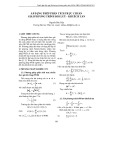
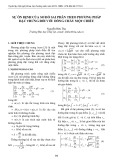
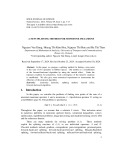
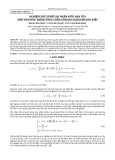
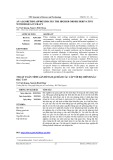
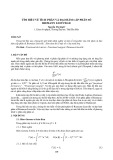
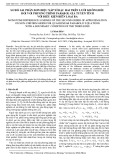
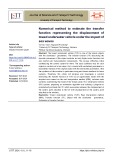
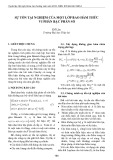















![Quyển ghi Xác suất và Thống kê [chuẩn nhất]](https://cdn.tailieu.vn/images/document/thumbnail/2025/20251030/anh26012006/135x160/68811762164229.jpg)
